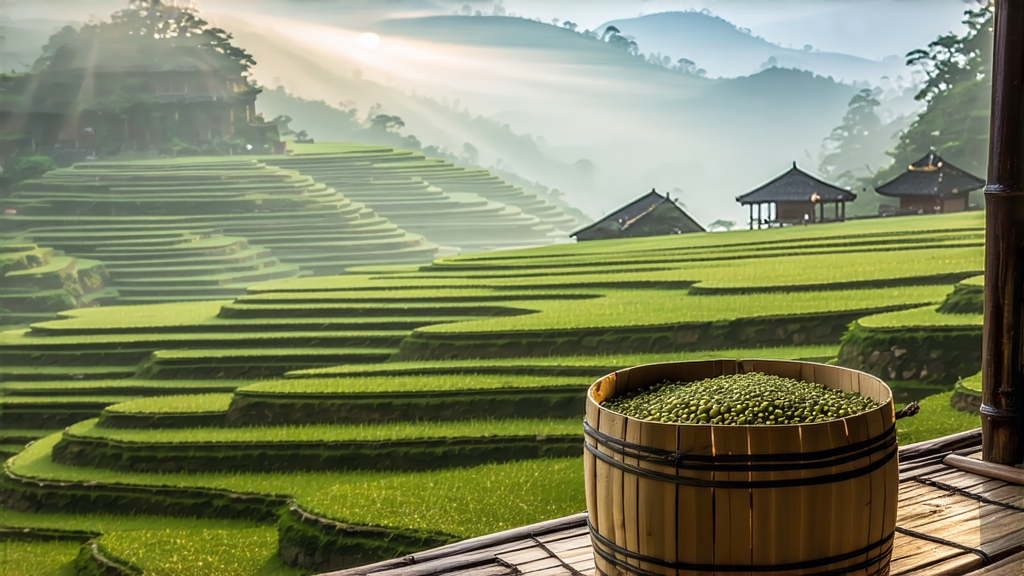
High on the northern rim of the Sichuan Basin, where the Himalayas throw their first gentle spurs toward the Yangtze, the mist never quite lifts from the bamboo-covered peaks of Meng Ding Shan. At elevations between 800 and 1 400 m, the mountain traps humid monsoon clouds that condense into a perpetual veil; this veil filters sunlight into a soft, silver glow and coaxes the tea bushes to produce buds so tender they can be rolled between two fingers without bruising. It is here, in a micro-climate Chinese poets once called “the nursery of immortals,” that Meng Ding Huang Ya—literally “Meng Ding Yellow Bud”—has been plucked for more than twelve centuries.
Historical scrolls kept in the county archive of Ya’an credit the Buddhist monk Wu Lizhen with planting the first seven tea bushes on Meng Ding in 53 BCE. During the Tang dynasty those bushes were declared “celestial,” and their spring buds were compressed into tiny cakes, wrapped in silk, and sent by fast courier along the Jiannan Road to Chang’an’s imperial court. By the Song dynasty the cakes had given way to loose leaf, and the leaf had turned yellow thanks to a newly invented “sealing-yellow” step that lent a mellow sweetness unknown to green tea. The Ming emperor Hongwu, notoriously frugal, abolished most tribute teas, yet he kept Meng Ding Huang Ya on the list, remarking that “its quiet fragrance reminds the ruler to be gentle.” When the Qing court switched to darker, oxidised teas from Fujian, Meng Ding yellow tea fell into obscurity, surviving only as a local monastic beverage until 1959, when Chinese tea scientists re-discovered the technique in a temple manuscript and re-established commercial production. Today fewer than 12 t of authentic Meng Ding Huang Ya reach the market each year, making it rarer than silver-tipped Darjeeling or pre-Qingming Long Jing.
Although all yellow teas share the hallmark “slow yellowing” phase, Meng Ding Huang Ya is distinguished by its raw material: a tiny, purple-green cultivar named “Meng Ding #9” whose leaves are scarcely 2 cm long when fully open. Picking occurs during a ten-day window in late March, before the Qingming festival, when each bud still wears a faint down and carries one just-unfurling leaf. Experienced pluckers use a twisting motion that snaps the bud off at the petiole without tearing the stem; this prevents premature oxidation during the long trek down the mountain.
The craft begins within minutes of plucking. Baskets are carried to the temple courtyard where shallow bamboo trays, called qing kuang, await. Leaves are spread no thicker than one finger-width and allowed to wither for 90–120 min, losing about 15 % moisture while absorbing the courtyard’s cool, jasmine-scented air. Next comes the first firing, sha qing, but here Meng Ding Huang Ya departs from green-tea orthodoxy. Instead of the usual 280 °C wok, the tea master uses a brass pan heated to only 160 °C; buds are tossed for precisely 90 s, just enough to denature leaf enzymes while preserving a faint grassy note.
The crucial step, men huang (“sealing yellow”), follows immediately. The still-warm buds are wrapped in squares of steamed cotton cloth, then stacked in a bamboo steamer and placed above a brazier of slowly smouldering cypress wood. For the next 48 h the tea master returns every 4 h to unwrap, fluff, and re-wrap the bundles; temperature inside the cloth hovers between 35 and 40 °C, ideal for non-enzymatic browning. Chlorophyll degrades into pheophytin, catechins dimerise, and a cascade of Strecker reactions produces maltol and 3-methyl-butanal—compounds that lend the tea its signature cocoa-nutty aroma. By the end of men huang the leaf has turned a dull olive-gold and feels velvety to the touch.
A second, gentler firing completes the transformation. The buds are rolled for 20 min under a linen-covered board to straighten their shape, then dried in three passes: 80 °C for 30 min, 60 °C for 60 min, and finally 45 °C for 120 min. Each pass is separated by a 30 min rest so that residual moisture migrates from stem to leaf, ensuring even drying. The finished tea resembles tiny golden spears: uniformly 15 mm long